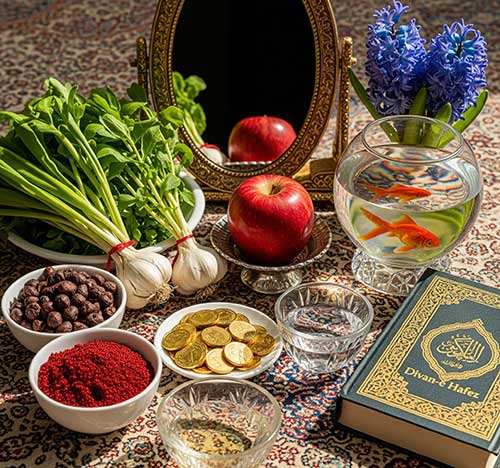Nowruz and the Iranian Haft-Seen: A Celebration of Renewal and Hope
7/4/2025
Nowruz, meaning "New Day," is far more than just a calendar event; it's a profound and ancient celebration marking the vernal equinox and the beginning of spring. Observed by millions across Iran, Afghanistan, Central Asian countries, and various communities worldwide, Nowruz embodies themes of renewal, rebirth, and hope. This vibrant festival, steeped in thousands of years of history, is a testament to the enduring cultural heritage of Persia and its neighboring regions. At the heart of Nowruz lies the Haft-Seen (literally "Seven S's") a symbolic spread of seven items, each beginning with the Persian letter "seen" (س), that collectively represent life's essential elements and aspirations for the new year.
The origins of Nowruz are deeply intertwined with Zoroastrianism, one of the world's oldest monotheistic religions, which originated in ancient Persia. In Zoroastrian tradition, the equinox symbolizes the triumph of good over evil, light over darkness, and the revitalization of nature after the dormancy of winter. For centuries, this reverence for nature's cycle has been central to the Nowruz spirit. While its roots are ancient, Nowruz has evolved into a secular celebration of spring that transcends religious boundaries, embracing people of all faiths and backgrounds who cherish its message of peace, prosperity, and harmony.

The Haft-Seen: A Table of Timeless Symbolism
The Haft-Seen table is the focal point of Nowruz celebrations, meticulously arranged in homes days before the vernal equinox.
Each item on the Haft-Seen is carefully chosen for its profound symbolic meaning, collectively offering a wish list for the year ahead:
Sabzeh (سبزه): This dish of wheat, barley, lentil, or mung bean sprouts, grown in a dish, symbolizes rebirth, growth, and renewal. It represents the greening of the earth and the promise of a prosperous year. Families often start growing their sabzeh weeks in advance, tending to it with care as a living representation of their hopes.
Samanu (سمنو): A sweet, thick pudding made from wheat germ, Samanu embodies abundance, fertility, and the sweetness of life. Its preparation is often a communal affair, symbolizing shared joy and prosperity.
Senjed (سنجد): The dried fruit of the oleaster tree, Senjed signifies love, affection, and wisdom. Its subtle sweetness and delicate aroma add to the sensory richness of the Haft-Seen.
Sir (سیر): Garlic, or Sir, represents health, medicine, and protection from evil. Its inclusion on the Haft-Seen underscores the importance of well-being and purification in the new year.
Sib (سیب): Apples, or Sib, symbolize beauty, health, and a fruitful life. Their vibrant color and fresh scent bring a sense of vitality to the spread.
Sumac (سماق): This crushed spice, Sumac, with its deep red hue, represents the color of the sunrise and the triumph of good over evil. It also symbolizes patience and tolerance.
Serkeh (سرکه): Vinegar, or Serkeh, symbolizes age, patience, and wisdom. It reminds us of life's challenges and the importance of resilience and endurance.
Beyond these seven essential "S" items, other elements often adorn the Haft-Seen, further enriching its symbolism:
A mirror (آینه): Represents self-reflection, truth, and clarity for the year ahead.
Candles (شمع): Symbolize enlightenment, happiness, and the warmth of light conquering darkness.
Colored eggs (تخم مرغ رنگی): Represent fertility and new beginnings, particularly for children.
A bowl of water with goldfish (ماهی قرمز): Symbolizes life, movement, and prosperity.
Coins (سکه): Represent wealth and prosperity.
Hyacinths (سنبل) or other spring flowers: Add beauty and fragrance, symbolizing the arrival of spring.
A holy book (e.g., Quran, Avesta, Divan of Hafez): Provides spiritual guidance and blessings for the new year.
Nowruz Traditions and Celebrations
The preparations for Nowruz begin weeks in advance with Khaneh Tekani (خانه تکانی), a thorough spring cleaning of homes. This tradition not only physically cleanses the living space but also spiritually purifies it, making room for new beginnings.
The moment of the vernal equinox, known as Saal Tahvil (سال تحویل), is the most anticipated part of Nowruz. Families gather around the Haft-Seen, often dressed in new clothes, to await the exact moment of the equinox. This is a time of quiet reflection, prayer, and wishes for a blessed new year. Once the moment arrives, hugs, kisses, and exchanges of "Nowruz Mobarak!" (Happy Nowruz!) fill the air. Elders traditionally give Eidi (عیدی), small gifts of money, to younger family members, symbolizing blessings and good fortune.
Nowruz celebrations extend for nearly two weeks, filled with visits to family and friends. Did-o-Bazdid (دید و بازدید), the reciprocal visiting of homes, is a cornerstone of the festivities, strengthening social bonds and fostering community spirit. Guests are welcomed with tea, sweets, fruits, and nuts.
The thirteen-day celebration culminates in Sizdah Be-Dar (سیزده بدر), meaning "thirteen outdoors," on the thirteenth day of the new year. On this day, families flock to parks, fields, and natural spaces to spend the day outdoors, enjoying picnics, playing games, and dancing. It's believed that by spending the day outside, people ward off bad luck associated with the number thirteen. A key ritual of Sizdah Be-Dar is throwing the sabzeh into flowing water, symbolizing the release of negative energy and the return of the growth to nature.
A Global Message of Peace and Renewal
Nowruz is more than just a festival; it's a cultural phenomenon that has transcended geographical boundaries, becoming a symbol of shared heritage and universal values. In 2009, Nowruz was officially inscribed on UNESCO's Representative List of the Intangible Cultural Heritage of Humanity, recognizing its significance as a promotion of peace and solidarity.
The enduring appeal of Nowruz lies in its timeless message. It reminds us of the cyclical nature of life, the importance of hope, and the power of renewal. As winter gives way to spring, Nowruz encourages us to embrace change, clean our slates, and look forward to a future filled with growth, prosperity, and harmony. It is a vibrant tapestry woven from ancient traditions, heartfelt symbolism, and the enduring human desire for a new beginning.
